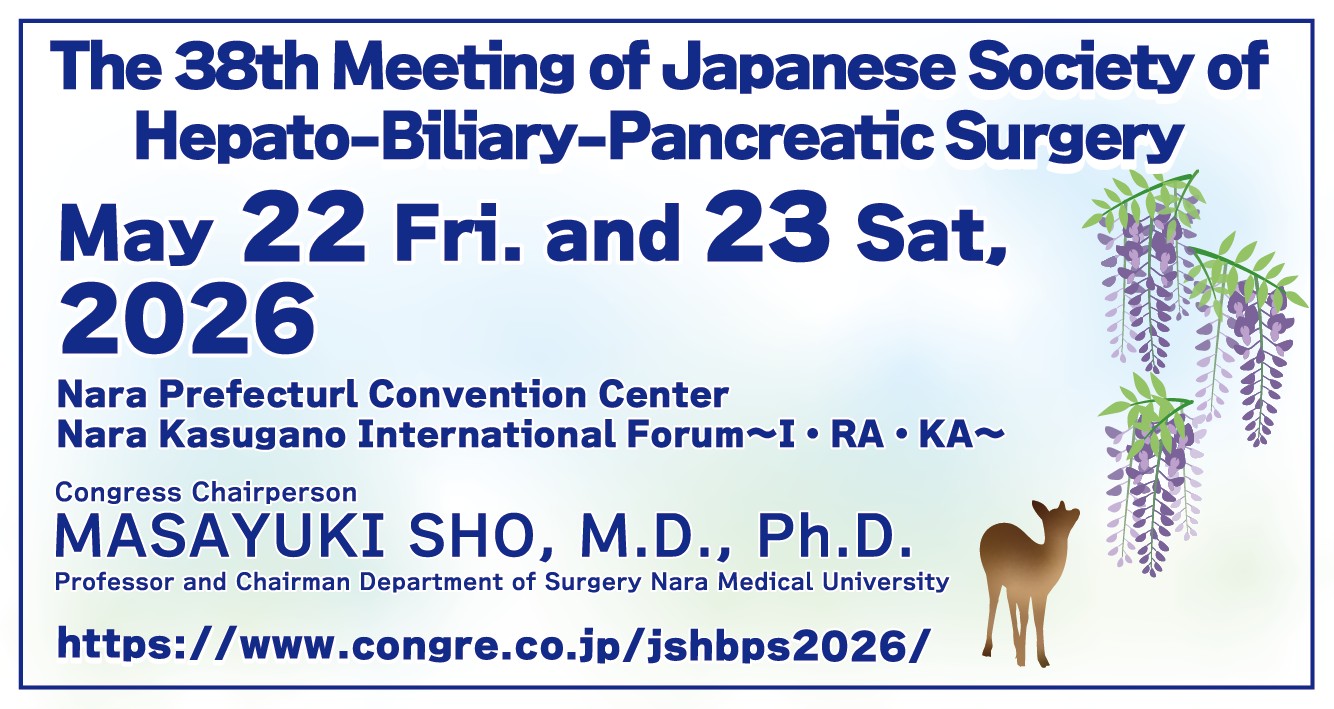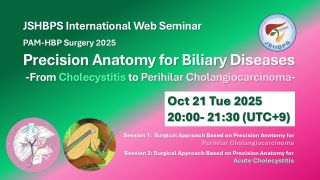
Tadahiro Takada
Founding President
Japanese Society of Hepato-Biliary-Pancreatic Surgery
On May 31, 2012, at the 24th Meeting of the Japanese Society of Hepato-Biliary-Pancreatic Surgery held in Osaka. I officially retired from my post as chairman of the board of directors.
I would like to express my deep gratitude for recognition as honorary founder and honorary chairman of the board of directors, titles bestowed upon me at that meeting.
In 1988, a discussion took place concerning the creation of an academic society focused on hepato-hiliary-pancreatic surgery, and this discussion was followed by the establishment of an academic society for expert surgeons in this field and for surgeons seeking further development of their skills. In 1989, the first Japan Hepato-Biliary-Pancreatic Forum was held. In 1993, the society name was changed to the present Japanese Society of Hepato-Biliary-Pancreatic Surgery.
I. Targets of the operation and activities of the Society
- Art:
To support further development and dissemination of the art of hepato-biliary-pancreatic surgery and to facilitate the acquisition of high-level skills. - Science:
To continue efforts to make this Society an organization of high scientific value. To engage in various project studies as well as the publication of research reports. - Publication of the Journal of Hepato-Biliary-Pancreatic Sciences
Guided by the motto, “Sending a message to and exchanging information with the world,” the Society has no official journal printed in Japanese. The Society started publication of its official journal in English (a rarity at the time), known as the Journal of Hepato-Biliary-Pancreatic Surgery. The official journal was later renamed the Journal of Hepato-Biliary-Pancreatic Sciences (JHBPS). Only a few societies in Japan publish their official journals in English. - Establishment of a Board certification system for expert surgeon (Hepatobiliary-Pancreatic field)
To foster and accredit those surgeons who are able to perform high-level hepato-biliary-pancreatic surgery safely and reliably at an approved facility, under board-certified instructors and by means of prescribed procedures. - Internationalization:
To promote joint research between Japan, Korea, and Taiwan and to encourage collaborative research and exchange throughout the Asia-Pacific region. With a goal toward internationalization, the Society’s “Eigoka” (use of English as the primary language) policy should be further advocated.
II. History of the JHBPS
- Publication of the Society’s official journal in English (without an accompanying Japanese edition) began in 1993. The Impact Factor in 2011 was 2.099.
III. Internationalization of the Society
- Observership:
Taking advantage of the International Symposium on Pancreatoduodenectomy held in Tokyo in 1993, the Society began an exchange with Dr. L. William Traverso (St. Luke’s Clinic--Center for Pancreatic and Liver Diseases and formerly of Virginia Mason Medical Center, USA) and Dr. Howard Reber (UCLA Medical Center, USA). This was followed by communication with Dr. Michael Sarr (Mayo Clinic, USA), leading to the initiation of study-abroad activities in 1997. - 5th World Congress of the International Hepato-Pancreato-Biliary Association, Tokyo
The 5th World Congress of the International Hepato-Pancreato-Biliary Association (IHPBA) was held in Tokyo in 2002 under the sponsorship of the Science Council of Japan and with the support of the Japanese Society of Hepato-Pancreato-Biliary Surgery. Tadahiro Takada served as convenor. - Road to the Asian-Pacific Hepatic-Pancreato-Biliary Association
The Asian Society of Hepato-Biliary-Pancreatic Surgery (ASHBPS) started in 1991 (President: Tadahiro Takada). The first ASHBPS Congress was held that year in Bangkok, with Professor Thamanoon Bariyapongs as the Congress president.
New Frontiers in Hepato-Biliary-Pancreatic Surgery was published in compilation of excellent papers from the ASHBPS Congress, by Bangkok Medical Publishers, Thailand.
By 2004, the ASHBPS meetings were being held bi-annually. In 2006, the ASHBPS joined with the IHPBA under the name Asian-Pacific HPBA (A-P HPBA), with Tadahiro Takada as the Founding President and Masao Tanaka as the President. - Birth of the Japan Chapter of IHPBA/A-P HPBA
A remarkable decrease in the number of Japanese IHPBA members was reported by.Norihiro Kokudo, responsible for increasing membership, called for the participation of Japanese Society of Hepato-Biliary-Pancreatic Surgery members. By June 2012, as a result of his efforts, the Japan IHPBA/A-P HPBA chapter had increased to the second largest in membership after that of the U.S.
IV. Birth of the board certification system for expert surgeons(field of hepatobiliary-pancreatic surgery)
- Establishment of the board certification system for expert surgeons was announced at the 16th Annual Meeting held in Osaka in 2004.
- The ability to perform high-level hepato-biliary-pancreatic surgery safely and reliably is a requirement for an expert surgeon. A surgical manual was published in 2010. Japanese, English (JHBPS Vol. 19, No. 1-3, 2012), and Korean editions of “Highly Advanced Surgery in the Hepatobiliary and Pancreatic Field” have also been published.
- The Japanese Society of Hepato-Biliary-Pancreatic Surgery, recognized its first 12 expert surgeons at the 23rd Annual Meeting held in 2011, 12 were recognized at the 24th Annual Meeting in 2012, 30 at the 25th Annual Meeting in 2013, and 31 at the 26th Annual Meeting in 2014.
V. Alliance with the Japan Society for Biliary Tract Research
An alliance between the Japanese Society of Hepato-Biliary-Pancreatic Surgery and the Japan Society for Biliary Tract Research was established in 2005.
VI. Activities
- Revision of the 5th edition of the “Classification of Biliary Tract Cancers” began in 2005.
- 2005: Enterprises for biliary tract cancer statistics registry began.
Publication of Biliary tract cancer treatment: 5,584 results from the Biliary Tract Cancer Statistics Registry from 1998 to 2004 in Japan. JHBPS,Vol. 16, No. 1 was published in 2009. - Publication of Clinical Practice Guidelines for the Management of Biliary Tract Cancer and Ampullary Carcinoma.
The Japanese edition was published in 2007.
Clinical practice guidelines for the management of biliary tract and ampullary carcinoma (JHBPS , Vol. 15, No. 1, 2008)was published in 2008. - Creation of Committee for the management of perihilar cholangiocarcinoma and preparation for publication of management guidelines began.
- Management Guidelines of Perihilar Cholangiocarcinoma (6th Edition) was published.
- Clinical Practice Guidelines for the Management of Biliary Tract Cancer and Ampullary Carcinoma (2nd Edition) was published.
- Classification of biliary tract cancers established by Japanese Society of Hepato-Biliary-Pancreatic Surgery (3rd English edition) (JHBPS, Vol. 22, No. 3) was published in 2015.
- Clinical practice guidelines for management of biliary tract cancers(2nd English edition) (JHBPS Vol. 22, No. 4) was published in 2015.
VII. Preparation and publication of international guidelines
- Publication of evidence-based Guidelines for the Management of Acute Cholangitis and Acute Cholecystitis occurred in 2007. However, we found the evidence poor and the international diagnostic criteria insufficient. After consulting Professor Steven Strasberg (Washington University School of Medicine, Saint Louis, USA) and experts from IHPBA, we decided that the guidelines lacking evidence would be subject to a review process and re-shaped, if necessary, on the basis of expert consensus. Out of the International Consensus Meeting held in Tokyo in 2006, the Tokyo Guidelines (JHBPS Vol. 14, No. 1, 2007) was published.
- After publication of the 2007 Tokyo Guidelines (TG07), we applied the criteria to actual clinical situations only to find that diagnostic sensitivity was low, the severity assessment criteria were not clinically suitable, the widely used Charcot's triad was low in sensitivity, and many actual disease conditions were misclassified by the system (as false negatives).
In light of these inadequacies, the Tokyo Guidelines Revision Committee began meeting and consulting with international experts., TG13 (revised edition) was published in February 2013.
VIII. Preparation and publication of international guidelines
- Under the leadership of the Society, multi-institutional joint project studies in hepato-biliary-pancreatic sciences have been conducted since 2008. Papers written in English have already been published.
- Japan-Korea and Japan-Taiwan joint research began in 2011, and a draft was made public at the 24th Annual Meeting of the Japanese Society of Hepato-Biliary-Pancreatic Surgery. Frequent exchange of opinions and meetings in thiese joint studies have been taking place.
IX. Toward internationalization
- As a step toward internationalization, seminars on the Japan-Korea and Japan-Taiwan joint research projects were included in the program at the 24th Annual Meeting in Osaka, and some International Sessions were conducted in English.
- At the 25th Annual Meeting in Utsunomiya, slides, poster presentations, and video sessions were conducted all in English. An international symposium also took place in English.
- About 40% of the program at the 26th Annual Meeting in Wakayama was held in English. The 28th Joing A-PHPBA & JSHBPS in Yokohama is to be held completely in English.
The understanding and cooperation of all Society members for the globalization of our Society are greatly appreciated.




